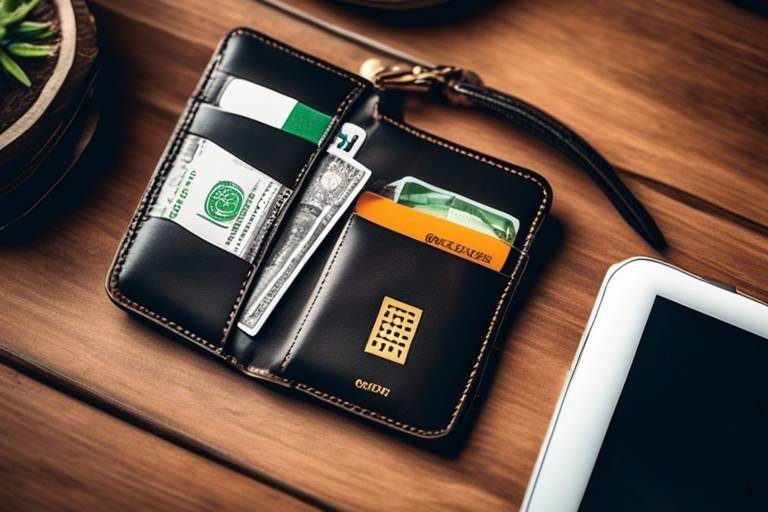The Importance of Community Support for Wallet Development
In the rapidly evolving world of digital finance, the development of digital wallets has become a focal point for both innovation and user engagement. But what truly fuels this development? The answer lies in the **community support** that surrounds these digital tools. Just like a thriving garden needs sunlight, water, and nutrients, wallet development thrives on the active participation and contributions of its community. This article delves into the vital role that community support plays in the development of digital wallets, emphasizing its profound impact on innovation, security, user engagement, and overall success in the fintech landscape.
When we think about wallets, we often picture a simple tool for storing cash or cards. However, digital wallets are so much more than that. They are complex systems designed to facilitate transactions, store cryptocurrencies, and manage user assets in a secure environment. As the demand for seamless digital transactions grows, the importance of wallet technology cannot be overstated. It is not just about having a wallet; it’s about having a wallet that is continuously evolving to meet the changing needs of its users.
Community support acts as the backbone of wallet development. Engaged users provide invaluable feedback and ideas that can shape the features of the wallet, ensuring that it remains relevant and competitive. Imagine a bustling marketplace where vendors listen to their customers and tailor their offerings to meet demands. This is what community involvement does for wallet developers—it creates a dynamic environment where innovation can flourish.
In the realm of digital wallets, community support manifests in various forms, from direct feedback on user experiences to collaborative coding efforts. The more users engage with the wallet, the more insights developers gain, leading to enhancements that resonate with the audience. This collaborative spirit not only drives innovation but also fosters a sense of ownership among users, making them feel like integral parts of the development process.
To illustrate the impact of community support, let’s consider the role of feedback mechanisms. These are crucial for gathering user insights and prioritizing enhancements. Developers can utilize methods such as surveys, forums, and social media polls to foster constructive dialogue. For instance, when users express their thoughts on a new feature, developers can quickly identify what works and what doesn’t, allowing them to pivot and adapt swiftly.
Furthermore, beta testing programs represent another excellent opportunity for community involvement. By allowing community members to try new features before their official launch, developers can gather critical feedback that enhances product quality. This not only leads to better products but also creates a sense of loyalty and engagement among users, who feel their opinions genuinely matter.
Moreover, the open-source movement has revolutionized how wallet development occurs. With community members contributing code, sharing resources, and collaborating on projects, the potential for improvement is immense. Open-source contributions can lead to enhanced functionality and security, as diverse perspectives and expertise come together to tackle challenges. This collective effort can significantly bolster the wallet's resilience against potential threats.
Speaking of security, it is a paramount concern in wallet development. Engaged communities play a critical role in identifying vulnerabilities and contributing to robust security measures. When users are actively involved, they can report issues, suggest improvements, and even help in the testing phase, ensuring that user assets remain safe from threats and breaches. Just as a neighborhood watch keeps a community safe, a vigilant user base can help safeguard digital wallets.
In summary, the importance of community support in wallet development cannot be overstated. It fuels innovation, enhances security, and fosters user engagement. As digital wallets continue to evolve, the role of the community will only grow more significant, paving the way for a more secure and user-friendly digital finance landscape.
- What is a digital wallet?
A digital wallet is an electronic device or online service that allows individuals to make electronic transactions, store digital currency, and manage their assets securely. - How does community support impact wallet development?
Community support drives innovation, enhances security, and fosters user engagement, making wallets more effective and user-friendly. - Why is security important in wallet development?
Security is crucial because digital wallets store sensitive financial information. Community involvement helps identify vulnerabilities and strengthen security measures. - What are feedback mechanisms?
Feedback mechanisms are tools and methods used by developers to gather user insights, such as surveys, forums, and social media interactions. - How can I get involved in wallet development?
You can participate by providing feedback, joining beta testing programs, or contributing to open-source projects related to wallet development.

Understanding Wallet Development
Wallet development encompasses the creation and enhancement of digital wallets, which are essential tools in the modern financial landscape. These wallets facilitate transactions, store cryptocurrencies, and manage user assets, making them pivotal in the realm of fintech. As we dive deeper into wallet technology, it's important to recognize that the evolution of these wallets is not just a technical endeavor; it's a response to the dynamic needs of users and the ever-changing market.
At its core, wallet development involves several fundamental aspects that contribute to its growing significance:
- Transaction Facilitation: Digital wallets enable seamless transactions, allowing users to send and receive money with just a few taps on their devices. This convenience has revolutionized how we think about money.
- Asset Management: Users can manage various assets, including cryptocurrencies and digital tokens, all in one place. This centralized management simplifies the user experience and enhances accessibility.
- Security Features: With the rise of digital transactions comes the need for robust security measures. Wallet developers must prioritize security to protect user assets from potential threats.
As the demand for digital wallets continues to surge, developers are increasingly focusing on creating user-friendly interfaces that cater to both tech-savvy individuals and those new to the digital finance world. This emphasis on user experience is crucial, as it determines how easily users can navigate their wallets and utilize their features.
Moreover, the integration of advanced technologies such as blockchain and biometric authentication is reshaping wallet development. Blockchain technology ensures transparency and security, while biometric features like fingerprint scanning offer an additional layer of protection. This blend of innovation and security not only enhances user trust but also sets the stage for the wallet's future growth.
In summary, understanding wallet development is about recognizing its multifaceted nature. It's not just about building a tool for transactions; it's about creating a comprehensive ecosystem that supports users in managing their finances securely and efficiently. As we move forward, the role of community support in this development process will be crucial, driving innovation and ensuring that wallets evolve to meet the needs of their users.

The Role of Community in Innovation
In the rapidly evolving world of digital wallets, community involvement is not just beneficial; it's essential. When users feel a part of the development process, they become more than just customers—they transform into active participants in the innovation journey. Think of it like a potluck dinner: when everyone brings their unique dish, the meal is not only more varied but also more enjoyable. Similarly, when users contribute their feedback and ideas, the wallet evolves in ways that developers might not have anticipated.
Engaged users provide invaluable insights that can shape the direction of wallet features. This collaboration ensures that the wallet remains relevant and competitive in a crowded market. For instance, when users express a need for enhanced security features or user-friendly interfaces, developers can prioritize these enhancements. The result? A product that resonates with its audience and meets their evolving needs. This type of responsive development fosters trust and encourages users to remain loyal to the wallet brand.
One of the most effective ways to harness community input is through feedback mechanisms. These can take various forms, such as surveys, forums, and direct communication channels. By creating spaces where users can voice their opinions, developers can gather insights that directly inform product updates. For example, a simple survey asking users about their experiences can lead to major feature improvements.
Feedback mechanisms are crucial for fostering a constructive dialogue between users and developers. By actively seeking user input, developers can create a continuous feedback loop that drives innovation. Users appreciate being heard, and when they see their suggestions implemented, it strengthens their connection to the wallet. This engagement can take many forms:
- Surveys: Quick questionnaires that gauge user satisfaction and feature requests.
- Forums: Online spaces where users can discuss their experiences and suggest improvements.
- Direct Communication: Channels like email or chat that allow users to share their thoughts directly with the development team.
These mechanisms not only improve the wallet's functionality but also create a sense of community ownership. When users feel that they have a say in the development process, their loyalty deepens, leading to increased user retention and advocacy.
Another innovative way to involve the community is through beta testing programs. These programs allow select community members to access new features before they are officially launched. This collaboration serves multiple purposes: it allows developers to gather real-world feedback, identify bugs, and make necessary adjustments before a full rollout. Moreover, it creates a sense of exclusivity and ownership among beta testers, making them feel like they're part of something special.
Imagine being invited to preview the latest blockbuster movie; you would likely feel a sense of excitement and pride. Similarly, beta testers become ambassadors for the wallet, sharing their experiences with their networks, which can generate buzz and anticipation for the official release.
The concept of open source contributions further amplifies community involvement in wallet development. By allowing developers from around the world to collaborate on the codebase, wallets can benefit from diverse perspectives and expertise. This collaborative approach not only enhances functionality but also strengthens security. When more eyes are on the code, vulnerabilities can be identified and addressed more swiftly.
In essence, open source contributions create a dynamic ecosystem where innovation thrives. Developers can share resources, tools, and ideas, leading to a more robust and secure wallet application. This communal spirit is reminiscent of a group project in school—everyone has a role to play, and when each member brings their strengths to the table, the final product is often greater than the sum of its parts.
Speaking of security, it’s a critical aspect of wallet development that cannot be overlooked. Engaged communities can play a vital role in identifying vulnerabilities and suggesting robust security measures. By fostering an environment where users feel comfortable reporting issues, developers can implement timely fixes and enhancements. This proactive approach not only protects user assets but also builds trust within the community, as users recognize that their safety is a priority.
In conclusion, the role of community in wallet innovation is multifaceted and essential. By leveraging user feedback, engaging in beta testing, and encouraging open source contributions, developers can create a product that not only meets but exceeds user expectations. The result is a thriving wallet ecosystem that prioritizes innovation, security, and user engagement.

Feedback Mechanisms
In the fast-paced world of digital wallet development, serve as the lifeblood of innovation and improvement. They allow developers to tap into the collective wisdom of their user base, ensuring that the product evolves in a way that resonates with its audience. Imagine a bustling marketplace where every voice matters; this is the essence of community feedback. By actively seeking input from users, developers can identify pain points, discover new feature ideas, and ultimately create a more user-friendly experience.
There are several effective methods to gather feedback, each with its unique advantages. For instance, surveys are a straightforward way to solicit structured responses from users. They can be designed to target specific areas of the wallet experience, such as usability or security features. When users are asked to rate their experience or suggest improvements, it opens the door for direct communication. On the other hand, forums provide a more informal setting where users can share their thoughts and engage in discussions. These platforms not only allow for immediate feedback but also foster a sense of community as users interact with one another.
Consider the impact of a well-structured feedback loop. Developers can create a continuous improvement cycle by analyzing feedback, implementing changes, and then soliciting further input on those changes. This iterative process keeps users engaged and invested in the wallet's development. It’s like a dance where both the developers and users move in sync, each step informed by the other’s rhythm. The result? A product that not only meets but exceeds user expectations, leading to higher satisfaction and retention rates.
Moreover, integrating feedback mechanisms into the wallet's ecosystem can also enhance user loyalty. When users see their suggestions being taken seriously and implemented, it fosters a sense of ownership. They feel like they are part of something bigger, contributing to a product that reflects their needs and preferences. This emotional connection can turn casual users into passionate advocates, spreading the word about the wallet's advantages and attracting new users.
In summary, feedback mechanisms are not just tools for gathering opinions; they are essential components of a successful wallet development strategy. By embracing user insights through surveys, forums, and continuous improvement cycles, developers can create a wallet that is not only functional but also beloved by its community. As we move forward, the role of user feedback will only become more critical in shaping the future of digital wallets.

Beta Testing Programs
Beta testing programs are like a sneak peek behind the curtain of wallet development. They offer a unique opportunity for community members to engage directly with the development process before a product is officially launched. Imagine being part of an exclusive club where you get to try out the latest features and provide feedback that can shape the final product. This collaborative effort not only enhances the quality of the wallet but also fosters a strong sense of ownership among users. When users feel like they have a stake in the product, their loyalty and engagement naturally increase.
During beta testing, developers can gather invaluable insights from real users navigating the wallet's features. This feedback is crucial in identifying any bugs or usability issues that might not have been apparent during internal testing. For example, a beta tester may discover that a particular feature isn’t intuitive, prompting developers to make necessary adjustments before the official release. This iterative process is essential for creating a product that truly meets the needs of its users.
Moreover, beta testing programs often create a buzz around the wallet, attracting attention from potential users who are eager to see what’s coming next. This excitement can be amplified through social media and community forums, where beta testers share their experiences and insights. As a result, a community-driven approach not only leads to a better product but also helps build anticipation and engagement within the broader user base.
In addition to improving product quality, beta testing programs can also serve as an educational tool. By participating in these programs, users gain a deeper understanding of the wallet's functionalities and security features, which can empower them to use the wallet more effectively once it goes live. This knowledge transfer is vital in creating a well-informed user community that can advocate for the wallet and contribute to its ongoing success.
To summarize, beta testing programs are a win-win for both developers and users. They foster collaboration, enhance product quality, and create a vibrant community around wallet development. By allowing users to play an active role in the development process, wallets can evolve in ways that are truly aligned with user needs and preferences, ultimately leading to greater success in the competitive fintech landscape.
- What is a beta testing program?
A beta testing program allows users to test a product before its official release, providing feedback to enhance its quality and functionality.
- How can I participate in a beta testing program?
Typically, you can sign up through the wallet's official website or community forums. Keep an eye out for announcements regarding new beta testing opportunities!
- What are the benefits of being a beta tester?
As a beta tester, you get early access to new features, the chance to influence product development, and a deeper understanding of the wallet's capabilities.
- Is there any risk involved in beta testing?
Yes, since beta versions may contain bugs or incomplete features, users should be prepared for potential issues. However, your feedback helps improve the final product!

Open Source Contributions
In the rapidly evolving world of digital wallets, play a pivotal role in shaping the landscape of wallet development. By allowing developers from all around the globe to collaborate, share code, and contribute to the enhancement of wallet functionalities, open source projects foster a sense of community and innovation that proprietary solutions often lack. Imagine a bustling marketplace where ideas flow freely; that’s what open source development embodies.
One of the most significant advantages of open source contributions is the diversity of perspectives they bring. When developers from different backgrounds and experiences come together, they create a melting pot of ideas that can lead to groundbreaking features. For example, a developer specializing in security can team up with a UI/UX designer to create a wallet interface that is not only secure but also user-friendly. This collaboration often results in a product that is more robust and well-rounded, ultimately benefiting the end-users.
Moreover, open source projects are characterized by transparency. Users can inspect the code, understand how their data is being handled, and even verify the security measures in place. This transparency builds trust, which is crucial in the fintech space where users are often apprehensive about the safety of their assets. A wallet backed by an active open source community can provide users with the peace of mind they need, knowing that they are using a solution that is continuously scrutinized and improved upon.
To illustrate the impact of open source contributions, let’s take a look at some successful wallet projects that have thrived thanks to community involvement:
| Wallet Name | Key Features | Community Contributions |
|---|---|---|
| Electrum | Lightweight, fast, and secure | Numerous plugins and security audits |
| MyEtherWallet | Ethereum wallet with user-friendly interface | Community-driven features and enhancements |
| Exodus | Multi-currency support with built-in exchange | Open source code contributions for new features |
Furthermore, open source contributions often lead to faster problem resolution. When a bug is discovered, a community of developers can jump in to address it quickly, often before it becomes a significant issue. This rapid response not only enhances the wallet’s reliability but also demonstrates a commitment to user safety and satisfaction.
In conclusion, the impact of open source contributions on wallet development cannot be overstated. They not only drive innovation and enhance security but also foster a sense of community among developers and users alike. As the fintech landscape continues to evolve, the collaborative spirit of open source will undoubtedly remain a cornerstone of successful wallet solutions.
- What is open source software? Open source software is software that allows users to access, modify, and distribute its source code freely.
- How do open source contributions improve wallet security? Contributions from a wide range of developers lead to more thorough testing and quicker identification of vulnerabilities.
- Can anyone contribute to open source wallet projects? Yes! Most open source projects welcome contributions from anyone with the necessary skills and enthusiasm.
- What are some popular open source wallets? Some popular open source wallets include Electrum, MyEtherWallet, and Exodus.

Community-Driven Security Enhancements
When it comes to digital wallets, security isn't just a feature—it's the foundation upon which user trust is built. In an era where cyber threats lurk at every corner of the internet, the role of the community in enhancing security measures cannot be overstated. Engaged users are not just passive consumers; they are active participants in the ongoing battle against vulnerabilities. By collaborating with developers, they can help identify potential weaknesses before they become serious issues.
One of the most effective ways communities contribute to security is through vulnerability reporting. When users encounter bugs or suspicious behavior, they can report these issues directly to the developers. This creates a feedback loop that is invaluable for improving the wallet's security. Developers can then prioritize these reports, ensuring that critical vulnerabilities are addressed swiftly. This proactive approach not only enhances the product but also fosters a culture of transparency and trust.
Moreover, community members often share their own experiences and insights regarding security practices. For instance, they might discuss best practices for creating strong passwords, or how to recognize phishing attempts. These discussions can take place in various forums, social media groups, or dedicated community platforms, creating a rich tapestry of shared knowledge. It’s like having a neighborhood watch for digital assets, where everyone looks out for one another.
In addition, many wallets have implemented bug bounty programs, which incentivize community members to find and report security flaws. This not only motivates users to engage but also helps developers focus their efforts on areas that need improvement. Here’s a simple breakdown of how a bug bounty program typically works:
| Step | Description |
|---|---|
| 1 | Users identify potential security vulnerabilities in the wallet. |
| 2 | Users report these vulnerabilities to the development team. |
| 3 | Developers assess the reports and prioritize fixes. |
| 4 | Users are rewarded (often financially) for their contributions. |
Through these community-driven initiatives, wallets not only become more secure but also gain a loyal user base that feels a sense of ownership. When users know that their feedback can lead to real changes, they become more invested in the product. This relationship transforms users from mere customers into advocates for the wallet, further enhancing its reputation in the fintech landscape. In essence, a secure wallet is not just about technology; it's about the community that supports and shapes it.
- What are community-driven security enhancements?
Community-driven security enhancements refer to the collaborative efforts between users and developers to identify and address security vulnerabilities in digital wallets. This includes reporting bugs, sharing best practices, and participating in bug bounty programs. - How can I report a security issue?
Most digital wallet platforms provide a dedicated channel for reporting security issues, such as a support email or a community forum. Always check the official website for the correct procedure. - What is a bug bounty program?
A bug bounty program is an initiative where developers reward users for identifying and reporting security vulnerabilities in their software. This encourages community participation in enhancing security.

User Engagement Strategies
User engagement is the lifeblood of any successful digital wallet. Without a thriving community of users actively participating, a wallet can quickly become irrelevant, no matter how advanced its technology. So, how do we keep our users engaged and invested in the wallet's evolution? The answer lies in implementing effective user engagement strategies that not only attract users but also retain them. One of the most significant aspects of engagement is fostering a sense of community. When users feel like they are part of something bigger, they are more likely to contribute, provide feedback, and advocate for the wallet.
One avenue to achieve this is through social media outreach. Platforms like Twitter, Facebook, and Reddit are not just for sharing news; they are vibrant ecosystems where users can interact, ask questions, and share their experiences. By actively participating in these conversations, wallet developers can create a two-way dialogue that fosters trust and loyalty. Imagine a scenario where a user tweets about a feature they love, and the developers respond with appreciation or even ask for more detailed feedback. This kind of interaction can turn a casual user into a passionate advocate.
Moreover, social media can be used to run campaigns that encourage user participation. For instance, creating contests where users can submit ideas for new features or improvements can yield innovative solutions while making users feel valued. It’s like hosting a brainstorming session that’s open to everyone, and the best part is that you get fresh ideas directly from the people who use your product every day.
Another crucial strategy is to provide educational initiatives. Knowledge is power, especially in the fintech world where users may feel overwhelmed by the complexities of digital wallets. By offering webinars, tutorials, and how-to guides, you can empower your users to understand and utilize the wallet's features fully. This not only enhances their experience but also builds a knowledgeable community that can help each other. Think of it as building a toolkit; the more tools you provide, the more capable your users become.
Additionally, consider hosting community events, both online and offline. These events can range from meetups to hackathons, where users can collaborate and innovate together. Imagine a group of enthusiastic users coming together to brainstorm new features or troubleshoot issues collectively. This kind of collaborative environment not only strengthens the community but also leads to better products. It’s like a potluck dinner; everyone brings a dish to the table, and together, you create a feast of ideas.
Lastly, don't underestimate the power of feedback. Regularly soliciting user opinions through surveys or feedback forms can provide invaluable insights into what users want and need. This continuous loop of feedback ensures that the wallet evolves in line with user expectations, leading to higher satisfaction and loyalty. After all, when users see that their voices are heard and that their suggestions lead to real changes, they are more likely to stick around.
In summary, user engagement strategies are essential for the success of any digital wallet. By leveraging social media, providing educational resources, hosting community events, and actively seeking user feedback, developers can create a vibrant ecosystem that benefits everyone involved. The goal is to make users feel like they are part of a community rather than just customers. When users feel connected, they are more likely to remain loyal and engaged, which ultimately leads to a thriving wallet that stands out in the competitive fintech landscape.
- Why is user engagement important for digital wallets? User engagement is crucial because it fosters loyalty, encourages feedback, and helps in the continuous improvement of the wallet's features.
- How can social media enhance user engagement? Social media provides a platform for direct interaction between developers and users, facilitating communication and community building.
- What types of educational initiatives can improve user knowledge? Webinars, tutorials, and informative articles can help users understand how to use the wallet effectively and securely.
- Are community events beneficial for wallet development? Yes, community events encourage collaboration and innovation, allowing users to contribute ideas and feedback directly.

Social Media Outreach
In today's digital age, is not just a trend; it's a necessity for any wallet development project aiming to thrive. Imagine social media as the bustling marketplace of the internet, where ideas flow as freely as currency. Engaging with users on platforms such as Twitter, Facebook, and Instagram allows developers to create a vibrant community around their digital wallets. This interaction is essential for gathering user insights, promoting new features, and fostering a sense of belonging among users.
One of the most effective strategies for social media outreach is to create content that resonates with your audience. This could be in the form of informative posts, engaging videos, or even live Q&A sessions. By sharing updates, tutorials, and tips, developers can educate users about wallet functionalities while simultaneously showcasing their commitment to transparency and community involvement. For instance, a wallet development team might post a quick video demonstrating a new feature, inviting users to share their thoughts in the comments. This not only boosts engagement but also provides immediate feedback.
Moreover, user-generated content can play a significant role in social media outreach. Encouraging users to share their experiences with the wallet can create a sense of ownership and pride within the community. For example, running a campaign where users post their favorite wallet features with a specific hashtag can generate buzz and attract new users. This kind of outreach not only promotes the wallet but also builds trust as potential users see real testimonials from their peers.
To further enhance social media engagement, wallet developers should consider leveraging analytics tools to track user interactions and preferences. By analyzing data on what type of content resonates most with their audience, developers can tailor their outreach strategies accordingly. This could involve posting more frequently about popular features or addressing common user concerns that arise from feedback.
Ultimately, successful social media outreach is about creating a two-way conversation. Developers should not only disseminate information but also actively listen to their community. Responding to comments, addressing concerns, and celebrating user achievements can transform a simple social media presence into a thriving community. By fostering this dialogue, wallet developers can ensure that they remain in tune with their users' needs, paving the way for future innovations and enhancements.
- Why is social media important for wallet development? Social media is crucial for engaging with users, gathering feedback, and promoting new features, all of which contribute to a successful wallet development process.
- How can I encourage user participation on social media? You can encourage participation by creating engaging content, running campaigns, and inviting users to share their experiences.
- What types of content should I share on social media? Sharing informative posts, tutorials, videos, and user-generated content can help keep your audience engaged and informed.
- How can I measure the success of my social media outreach? Utilizing analytics tools will help you track user interactions and preferences, allowing you to adjust your strategies for better engagement.

Educational Initiatives
In the rapidly evolving world of digital wallets, play a pivotal role in ensuring that users are not only aware of the features available to them but also understand how to use these tools effectively and securely. Imagine stepping into a new world where every transaction is seamless, yet every step is shrouded in mystery. That’s where education comes in. By empowering users with knowledge, we can demystify the complexities of wallet technology and foster a community that is both informed and engaged.
One of the most effective ways to educate users is through webinars. These interactive sessions allow users to ask questions in real-time, providing a platform for direct communication with developers and experts. For instance, a webinar could cover topics such as “How to Secure Your Wallet” or “Understanding Cryptocurrency Transactions.” These sessions not only enhance user knowledge but also create a sense of community as participants share their experiences and insights.
Moreover, tutorial videos are another excellent resource. Visual learners particularly benefit from seeing processes in action. A series of short, engaging videos can break down complicated topics, such as setting up a wallet or executing a transaction. By making these resources readily available on social media platforms and the wallet’s website, developers can ensure that users have access to information at their fingertips, whenever they need it.
Additionally, creating a comprehensive knowledge base on the wallet’s website can serve as a valuable resource. This repository can include articles, FAQs, and troubleshooting guides that users can refer to whenever they encounter issues or have questions. By organizing information in a user-friendly way, wallets can enhance user experience significantly. For example, a well-structured knowledge base might cover:
| Topic | Description |
|---|---|
| Wallet Setup | Step-by-step guide to creating your wallet. |
| Security Practices | Best practices to keep your assets safe. |
| Transaction Processes | How to send and receive cryptocurrencies. |
| Troubleshooting | Common issues and how to resolve them. |
Furthermore, engaging with the community through social media campaigns can amplify educational efforts. By sharing tips, infographics, and success stories, wallets can keep users informed and excited about their platform. For example, a campaign could highlight “Tip of the Week,” offering practical advice that users can implement immediately. This not only educates but also fosters a sense of belonging among users, encouraging them to share their own tips and tricks.
Finally, hosting community events can further solidify the relationship between users and developers. These events could range from informal meetups to more structured conferences where users can learn about the latest developments in wallet technology. Such gatherings provide an opportunity for users to network, share their experiences, and learn from each other, creating a vibrant ecosystem around the wallet.
In conclusion, educational initiatives are essential for the growth and success of digital wallets. By investing in user education through webinars, tutorial videos, knowledge bases, social media outreach, and community events, wallet developers can cultivate a knowledgeable user base that is not only engaged but also empowered to make the most of their digital wallets.
- What are the benefits of using educational resources for digital wallets?
Educational resources help users understand wallet features, enhance security, and improve overall user experience. - How can I participate in webinars or community events?
Keep an eye on the wallet's official website and social media channels for announcements regarding upcoming events. - Are tutorial videos available for all wallet features?
Most wallets strive to create comprehensive tutorial videos, but availability may vary. Check the wallet’s website for the latest resources. - What should I do if I encounter a problem with my wallet?
Refer to the knowledge base for troubleshooting tips or contact customer support for assistance.
Frequently Asked Questions
- What is a digital wallet?
A digital wallet is a software application that allows users to store, manage, and transact with digital currencies and assets. It provides a secure and convenient way to handle financial transactions, whether for cryptocurrencies or traditional currencies.
- How does community support influence wallet development?
Community support plays a crucial role in wallet development by providing valuable feedback, ideas, and resources. Engaged users help developers understand market needs, prioritize features, and enhance security measures, ultimately leading to a more robust product.
- What are feedback mechanisms in wallet development?
Feedback mechanisms are tools and processes that allow users to share their thoughts and suggestions with developers. This can include surveys, forums, and direct communication channels, all aimed at fostering constructive dialogue and improving the wallet's features.
- What is a beta testing program?
A beta testing program is an opportunity for community members to test new features of a wallet before they are officially launched. This collaboration not only helps identify bugs and improve functionality but also creates a sense of ownership and loyalty among users.
- How can open source contributions enhance wallet development?
Open source contributions enable developers and users to collaborate on wallet projects, sharing code and resources. This collective effort can lead to improved functionality, security, and innovation, as many minds work together to solve challenges.
- Why is security important in wallet development?
Security is paramount in wallet development because users' assets are at risk of theft and breaches. An engaged community can help identify vulnerabilities and contribute to creating robust security measures, ensuring that user funds remain safe.
- What user engagement strategies can be implemented?
Effective user engagement strategies include social media outreach, educational initiatives, and community events. These methods foster interaction and build a strong community around wallet development, keeping users informed and involved.
- How can social media be used to build a wallet community?
Social media platforms can be leveraged to connect with users, share updates, and promote discussions. By creating engaging content and encouraging user participation, developers can build a vibrant community that supports wallet development.
- What role do educational initiatives play in wallet development?
Educational initiatives empower users with knowledge about wallet features and security practices. By providing training and resources, developers can foster a knowledgeable and engaged user base, enhancing overall user satisfaction.



















